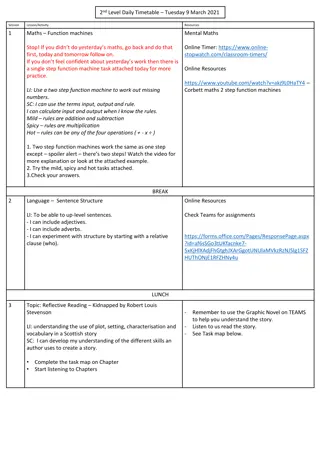
Understanding Friction and Forces in Movement
Explore the impact of friction on object movement, focusing on how it affects a bike's speed and maneuverability. Discover the forces at play, such as push force, air resistance, gravity, and friction between bike wheels and the road. Consider scenarios of sliding on different surfaces and the influence of wet and dry conditions on friction. Delve into the factors affecting friction and how they relate to everyday experiences.
Download Presentation

Please find below an Image/Link to download the presentation.
The content on the website is provided AS IS for your information and personal use only. It may not be sold, licensed, or shared on other websites without obtaining consent from the author. If you encounter any issues during the download, it is possible that the publisher has removed the file from their server.
You are allowed to download the files provided on this website for personal or commercial use, subject to the condition that they are used lawfully. All files are the property of their respective owners.
The content on the website is provided AS IS for your information and personal use only. It may not be sold, licensed, or shared on other websites without obtaining consent from the author.
E N D
Presentation Transcript
Science - Forces Tuesday 17thMarch I can explain how friction affects the movement of objects
What makes it harder to ride a bike quickly?
The forces acting on the bike may be: A push force from the pedals, air resistance, gravity friction between the wheels of the bike and the road https://www.youtube.com/watch?v=8AysbEMEv 50
Draw a picture of a bike and label the picture with the forces acting on the bike. A push force from the pedals, air resistance, gravity friction between the wheels of the bike and the road
Friction occurs between the surfaces (outside part) of any objects that is moving and in contact with each other e.g. the bike wheel and the road
Question to think about Is it easier to slide across the school hall in their socks or in their shoes? Why?
Smoother surfaces have less bumps on them, so there is less friction between our socks and the wooden floor than between our shoes and the wooden floor.
Questions to think about What if the floor is wet? What if the floor was dry?
Think about dry/wet slides and fields. Why is this? Water acts as a lubricant and that lubricants reduce friction by filling in the bumps in the surfaces. https://www.youtube.com/watch?v=Ps90zArJEJ Y
What can affect friction? https://www.youtube.com/watch?v=n2gQs1mc ZHA
the smoothness of the surfaces e.g. a smooth tyre will cause less friction than one with grooves and bumps the mass of the object e.g. a heavier bike will cause more friction than a lighter bike the size of the area of contact between the surfaces e.g. a wide tyre will cause greater friction than a smaller width tyre
Fact! Rub your hands together quickly what happens? This is how people first learnt to start fires and how we light matches today (by using friction to generate heat). Friction produces heat. If there was no friction, once an object was set in motion by a force, it would not stop moving (unless another force was used to stop it)






















